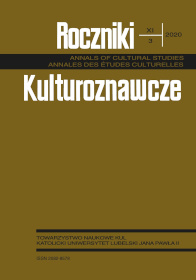From Despair to Faith: The Stilling of the Storm
Abstract
On 27 March, 2020, Pope Francis raised to the Lord a prayer of supplication in the name of the whole of humanity, seeking an end to the Covid-19 pandemic. In that occasion he gave an impressive homily based on the text of Mark 4,35-41, the famous account of the stilling of the storm. The present paper studies the triple attestation in the Synoptics (Matt 8,23-27; Mark 4,35-41; Luke 8,22-25), by considering the main difference on which it’s necessary to reflect with attention: Matthew reverses Mark and Luke in an important point. In fact, in Matt 8,26b, the injunction addressed to the wind and the sea falls after the question about the nature of the disciples’ faith, but in Mark 4,39b and Luke 8,24b the opposite happens: Jesus first calms the storm and only then asks the question about their faith. Why? With different strategies, all three Synoptics show that the disciples are men who, for all their slowness, will enter step by step into the anagnorisis of Jesus. In the course of the drama, the question with which the episode of the stilling of the storm concludes is really serious about Jesus’ identity. Beyond the differences of detail which emerge from the reading in parallel, the three Synoptics agree in conferring the same narrative emphasis on the disciples’ final question: “Who is this then, that even the wind and the sea obey him?” The question about who is this (τίς ἐστιν) forms the key query: if the Christological question continues after the description of the final solution, that means that, for the evangelists, the most important aspect is represented not by the miracle of the stilling of the storm but what that reveals about the identity of the protagonist of the story. The ultimate aim of the text concerns the identity of Jesus as God. The disciples are full of ὀλιγοπιστία because they are frightened of dying, not yet having learnt the perspective of eternal life: the one who speaks in the stilling of the storm is, yes, the Nazarene of history but still more the Risen One whom the great storm of death will have to obey in the morning of Easter.
References
Aletti, Jean-Noël. L’art de raconter Jésus Christ. L’écriture narrative de l’évangile de Luc. Paris: Éditions du Seuil, 1989 [Italian translation: L’arte di raccontare Gesù Cristo. La scrittura narrativa del vangelo di Luca. Translated by Lucio Sembrano. Brescia: Queriniana, 1991].
Aletti, Jean-Noël. Il Gesù di Luca. Bologna: EDB, 2012.
Aletti, Jean-Noël. Gesù una vita da raccontare. Il genere letterario dei vangeli di Matteo, Marco e Luca. Roma: San Paolo Edizioni, 2017.
Basta, Pasquale. “Il Vangelo come genere letterario e forma di linguaggio.” Italia Francescana 43 (2019), no. 1: 47–65.
Baum, Armin D., “Biographien im alttestamentlich-rabbinischen Stil. Zur Gattung der neutestamentlichen Evangelien.” Biblica 94 (2013), no. 4: 534-564.
Becker, Eve-Marie. Das Markus Evangelium im Rahmen antiker Historiographie. Tübingen: Mohr Siebeck, 2006.
Burridge, Richard A. Che cosa sono i vangeli?. Brescia: Paideia, 2008.
Desclaux, Jean-François. “L’esperance dans les chapitres 4 et 5 de l’évangile de St Marc.” Theologia Catholica 53 (2008), no. 4: 21–26.
Di Bianco, Nicola. “La ‘tempesta sedata’ (Mt 8,23-27): un miracolo ecosoteriologico?” Asprenas 57 (2010), no. 3: 331–344.
Dormeyer, Detlev. “Die Kompositionsmetapher ‘Evangelium Jesu Christi, des Sohnes Gottes’ Mk 1.1 Ihre theologische und literarische Aufgaben in der Jesus-Biographie des Markus.” New Testament Studies 33 (1987), no. 3: 452–468.
Fuchs, Albert. “Die ‘Seesturmperikope’ Mk 4:35-41 parr im Wandel der urkirchlichen Verkündigung.” Studien zum Neuen Testament und seiner Umwelt 15 (1990): 101–133 [Spanish translation: “La perícopa de la ‘tempestad calmada’ (Mc 4,35-41 par) en el kerigma de la Iglesia primitiva.” Estudios Bíblicos 48 (1990): 433-460].
Genette, Gérard. Palinsesti. Torino: Einaudi, 1997.
Martin, Aldo. “Il senso della fede e le ambivalenze necessarie in Mc 4,35-41.” Studia Patavina 54 (2007), no. 3: 513–536.
Poppi, Angelico. Sinossi e commento esegetico-spirituale dei quattro vangeli. Padova: Edizioni Messagero Padova, 2012.
Rhoads, David, Joanna Dewey, and Donald Michie. Mark as Story: An Introduction to the Narrative of a Gospel. 3rd edition. Minneapolis: Fortress Press, 2012.
Rodler, Lucia. I termini fondamentali della critica letteraria, Milano: B. Mondadori, 2004.
Smith, Justin Marc. Why ẞίος? On the Relationship between Gospel Genre and Implied Audience. London: T&T Clark, 2015.
Stanton, Graham N. Gesù e il «vangelo». Brescia: Claudiana, 2015.
Stone, Timothy J. “Following the Church Fathers: An Intertextual Path from Psalm 107 to Isaiah, Jonah, and Matthew 8:23-27.” Journal of Theological Interpretation 7 (2013), no. 1: 37–55.
Vironda, Marco. Gesù nel vangelo di Marco. Narratologia e cristologia. Bologna: EDB, 2003.
Weaver, Dorothy Jean. The irony of power: the politics of God within Matthew’s narrative. Eugene: Pickwick Publications, 2017.
Zappella, Luciano. “Euanghelion: il genere letterario dei Vangeli.” Bicudi. Bibbia Cultura Didattica. Accessed 6 February, 2017. http://www.bicudi.net/node/45.
Zeni, Stefano. “È il Signore che salva. Studio pragmatico di Mt 8,23-27.” Studia Patavina 67 (2020), no. 1: 35–47.





